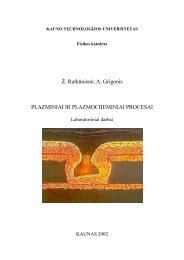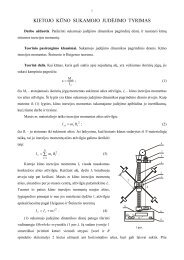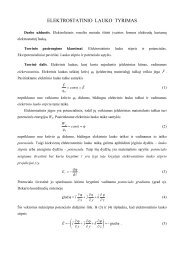PROCEEDINGS OF THE 7 INTERNATIONAL ... - Fizika
PROCEEDINGS OF THE 7 INTERNATIONAL ... - Fizika
PROCEEDINGS OF THE 7 INTERNATIONAL ... - Fizika
You also want an ePaper? Increase the reach of your titles
YUMPU automatically turns print PDFs into web optimized ePapers that Google loves.
O. Klepalov et al. / Medical Physics in the Baltic States 7 (2009) 83 - 85<br />
2. Personal dosimetry system<br />
The TLDs most commonly used in medical applications<br />
are LiF:Mg,Ti, LiF:Mg,Cu,P and Li2B4O7:Mn, because<br />
of their tissue equivalence. Other TLDs, which are used<br />
because of their high sensitivity, are CaSO4:Dy,<br />
Al2O3:C and CaF2:Mn.<br />
TLDs are available in various forms (e.g. powder, chips,<br />
rods and ribbons).<br />
A basic TLD reader system consists of a planchet for<br />
placing and heating the TLD, a PMT to detect the<br />
thermoluminescence light emission and convert it into<br />
an electrical signal linearly proportional to the detected<br />
photon fluence and an electrometer for recording the<br />
PMT signal as a charge or current. A basic schematic<br />
diagram of a TLD reader is shown in Fig. 1. TLDsystem<br />
which is used at Ignalina NPP is presented in<br />
Fig.2.<br />
Fig.1. TLD reader.<br />
Fig.2. Schematic diagram of the TLD system "RADOS"<br />
in Ignalina NPP.<br />
External exposure of personnel in the reference year<br />
was controlled once a month using thermoluminescent<br />
dosimeters.<br />
84<br />
Control of the externel exposure of personnel working<br />
under hazardous conditions was performed using both:<br />
thermoluminescent and electronic RAD dosimeters at<br />
the same time. The staff was allowed to work in a<br />
controlled area, presuming a dose of 0.2 mSv per day if,<br />
the difference between the collected individual dose and<br />
annual dose limit did not exceed 5.0 mSv after the work.<br />
If the difference between the collected individual dose<br />
and the annual dose level did not exceed 3.0 mSv, the<br />
staff was allowed to work under hazardous conditions,<br />
accounting 0.05 mSv per day.<br />
In 2008 individual dosimetric control was carried out<br />
for 3599 workers. 2320 workers of the NPP staff and<br />
1279 workers from contractor's organization staff (CO).<br />
3. Results<br />
The average individual dose of 0.91 mSv was estimated<br />
to CО + INPP personnel in 2008: 0.96 mSv for NPP<br />
personnel and 0.83 mSv for the personnel from contract<br />
organizations (Fig.3). Maximum individual dose for<br />
INPP staff was 18.09 mSv, maximum dose to sole<br />
worker from the contractor organization was 19.98<br />
mSv.<br />
Data on the number of investigated workers and<br />
received collective doses are provided: for 2008 - in<br />
Table1; for the whole period of operation of Ignalina<br />
NPP –in Fig.4.<br />
1. Table. 2008 Ignalina NPP and contractor's<br />
organization personnel irradiance indicators.








